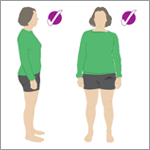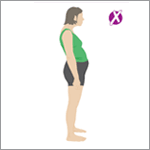Good posture when standing and walking can be challenging if you have issues with balance, weakness, stiffness, your vision or fatigue. Often you're thinking more about where your feet are going rather than your posture. If you stand or walk in a poor posture it can lead to back, neck or hip pain, and use more energy and increase fatigue.
The good news is, there are some simple things you can do to optimise your posture in standing and walking.
It's important to maintain as good a posture as possible. Here are some ways in which MS symptoms can lead to poor posture. Do any of them apply to you?
- If you have weakness in your legs or fatigue, you may find standing tiring and start to slouch.
- If you have vertigo or feel unsteady, you might find yourself looking down and stooping more.
- If your vision is impaired you may stoop or look down more in order to see better and identify obstacles.
When walking, try to keep as upright as possible. Looking at something just above your eyeline can help with this.
To check for obstacles, try scanning a few meters ahead rather than looking directly down, as this can keep you more upright.
When you have to stand for any length of time, to protect yourself from aches and possible falls, try to get into the habit of running through a simple checklist. For example, think 'head, shoulders, knees and toes'.
If you notice that you're starting to slouch or sag, consider whether you could pace your activities. For example, try alternating a standing activity with a sitting activity to give your legs a rest. You could also use a stool to perch on to do the task.
The same general advice applies if you find you are walking with a limp or dragging your feet after a while. Rest regularly to allow your legs to recover. Consider using a walking aid for longer distances so you are walking as 'normally' as you can. This makes your walking more efficient, less fatiguing and you are using more of the right muscles to help you walk.
Finally, if you are catching your toes or scuffing your feet when walking, this may affect the way you're walking, your posture and can be very fatiguing.
If you have foot drop, you may benefit from an orthotic. These come in many shapes and designs and your doctor, nurse or therapist can help with a referral for assessment for one of these or other kinds of equipment.
For a visual representation of the information covered in the text, please view the video at the top of the page.




